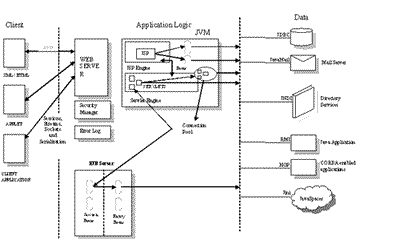J2EE ARCHITECTURE DESIGN



The above architecture perfectly lights up the Java design on how each and every aspect of java works as you can see how the transactions takes place from client to application logic and then from application logic to the backend database (or any data related to directory or other servers) along with which implemention of good business logic also exists. Business Logic involves in standardization of business practices by creating a single set of business funtions for the entire organization to access. If in case got to change a business rule also can be done easily by changing the business object. Business logic is basically implemented using Java beans and then at a higher level by servers like EJB, weblogic, websphere etc. Information relevant to these servers are linked in the Java service page (previous page).
Java 2 Enterprise Edition (J2EE), now known as Java EE (Enterprise Edition), is a platform-independent, Java-centric environment for developing, building, and deploying enterprise-level applications. Its architecture is designed to address the challenges of building large-scale, distributed, and multi-tiered applications. Here is an overview of J2EE architecture design:
1. Multi-Tiered Architecture: J2EE applications are typically designed using a multi-tiered architecture, which separates the application components into different tiers or layers. The common tiers include:
Client Tier: This is where the end-user interacts with the application. It can be a web browser, a standalone application, or a mobile device.
Presentation Tier: This layer handles the user interface and presentation logic. It includes technologies like JavaServer Faces (JSF), JavaServer Pages (JSP), and servlets.
Business Logic Tier: This layer contains the business logic and processes. It's responsible for processing data, performing calculations, and executing business rules. Enterprise JavaBeans (EJBs) are often used in this tier.
Integration Tier: Also known as the backend or resource tier, this layer handles integration with external systems, databases, and services. Java Database Connectivity (JDBC) and Java Messaging Service (JMS) are examples of technologies used here.
Enterprise Information System (EIS) Tier: This tier deals with enterprise databases, legacy systems, and other external resources.
2. Component-Based Development: J2EE promotes component-based development, where applications are built by assembling reusable components. The key components in J2EE are:
Servlets: Handle HTTP requests and responses.
JSP (JavaServer Pages): Allow embedding Java code in HTML for dynamic content generation.
Enterprise JavaBeans (EJB): Components that encapsulate business logic. They can be session beans (stateful or stateless), entity beans, or message-driven beans.
JavaBeans: Reusable Java components that follow specific conventions for property accessors and mutators.
Java Naming and Directory Interface (JNDI): Provides naming and directory services for locating components.
3. Container Services: J2EE applications run within containers provided by the application server. These containers provide services such as:
Servlet Container: Manages servlets and their lifecycle.
EJB Container: Manages Enterprise JavaBeans, handling transactions, security, concurrency, and persistence.
Web Container: Manages JSP files and their execution.
JMS Container: Manages messaging components.
Transaction Manager: Controls transactional behavior.
Security Manager: Enforces security policies.
4. Scalability and Load Balancing: J2EE applications are designed to be scalable. They can be deployed on multiple servers to handle high loads. Load balancing techniques distribute incoming requests across multiple servers for improved performance and reliability.
5. Security: J2EE provides a comprehensive security model with features like authentication, authorization, and data encryption. Security can be configured at various levels, including at the container level, application level, and even for individual components.
6. Messaging and Integration: J2EE applications can use JMS for asynchronous communication and messaging between components. Additionally, Java Connector Architecture (JCA) allows integration with Enterprise Information Systems (EIS) like databases and legacy systems.
7. Transactions: J2EE supports distributed transactions, allowing components in different tiers to participate in a single transaction. This ensures data consistency across multiple resources.
8. Performance Optimization: J2EE architecture design should consider performance optimization techniques, including caching, connection pooling, and optimizing database queries.
By adhering to these architectural principles, developers can create robust, scalable, and secure enterprise applications using J2EE/Java EE technologies.







